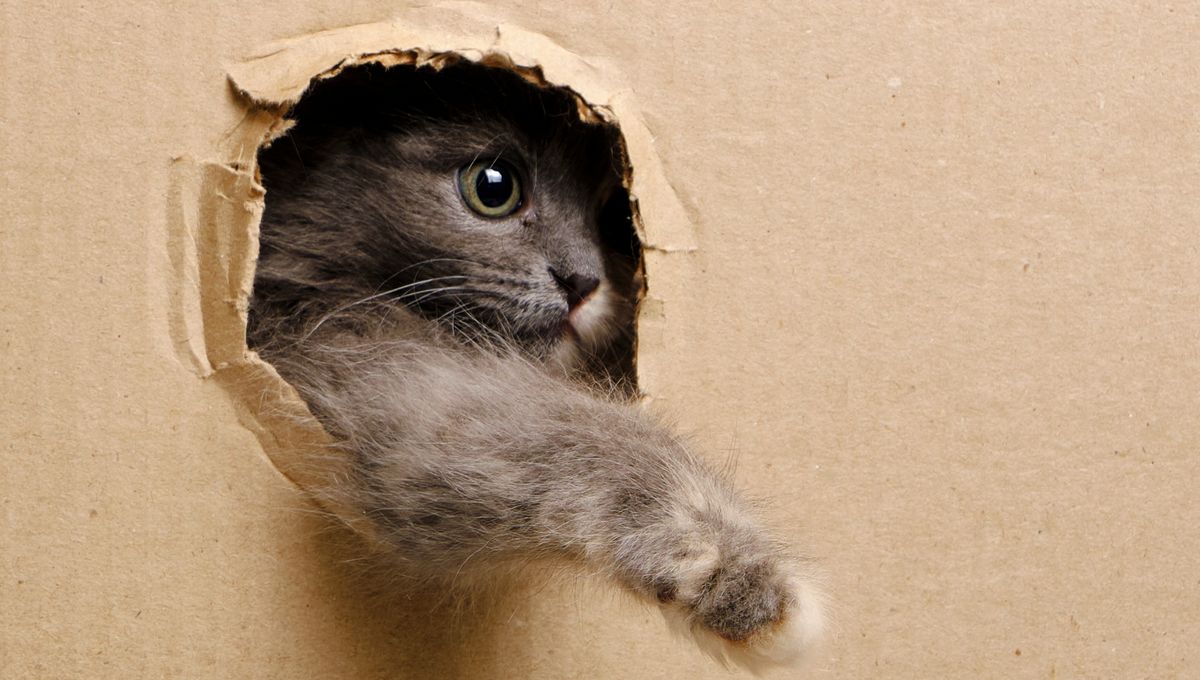
Cats appear to know (or at least consider) whether they can fit through a gap that is wide but not very high, indicating an understanding of their own dimensions. However, this only seems to work one way, as they will tackle a tall but narrow gap with confidence, even if it’s far too thin to let them pass.
Proof that cats can behave as both a solid and a liquid won a researcher an Ig Nobel Prize inspired by felines’ capacity to squeeze through gaps that appear impossibly small. Nevertheless, some holes are catproof. Dr Péter Pongrácz of Eötvös Lorand University, perhaps in search of a similar award, has tested if cats understand their own liquidity.
Some animals are known to be able to judge their own ability to fit through openings and will avoid trying those that are too small for them, indicating awareness of their own dimensions. Pongrácz himself has explored this with dogs, showing they will go around a shortcut they judge they can’t fit through. He also showed they understand their bodies can get in the way. According to Pongrácz, as he wrote in the paper; “So far no one has tested the ability for self-representation in cats.” Fortunately, he has not let this void in our knowledge go unaddressed.
In doing so, however, Pongrácz learned one reason such experiments have not been done before. Dogs were happy to be experimental subjects in his lab, as long as there was a food reward at the end. Cats refused to engage under such alien circumstances, forcing Pongrácz to find obliging human servants of cats who would let him into their shared home with cat-testing equipment in hand.
Pongrácz gave the cats an incentive to get to the other side of a screen with a rectangular hole in it, which he made progressively smaller in repeated trials. Sometimes the hole was made steadily narrower while keeping the same (adequate) height, in other cases its height was reduced while the width remained ample.
Some cats dealt with the problem by jumping over the screen, others investigated and turned away, their body language no doubt radiating that they had not been bested, they just were not interested in getting through. Most, however, made the effort to squeeze through, only to sometimes have to admit defeat.
Intriguingly, where dogs would hesitate before tackling holes that might prove too small, the cats only did so with openings that were short and wide, not those that were high and narrow. Moreover, taller cats were more likely to seek alternative paths than short ones when confronted with a vertically tight gap, even those they were able to eventually get through with difficulty.
Thus, it appears cats have an awareness that their bodies are a finite height, and assess short but wide holes to see if they expect to fit. On the other hand, when confronted with something narrow, they simply assume they can, only to sometimes learn their limits.
Pongrácz acknowledges the need to conduct the experiment in the cats’ home range meant he could not impose uniformity in how far they started from the screen, as he was able to do with dogs.
As amusing and delightful as this work may be to cat lovers, there is a deeper significance. Pongrácz notes that research into self-representation has traditionally used a binary model. Animals and children were considered either to be self-aware, as measured by their ability to recognize themselves in a mirror, or not. Yet like most binaries, this is destructively simplistic. Increasingly, psychologists and animal behaviorists recognize there are components to self-representation, and animals can have some without others. It seems he has found a particularly striking example of this.
Testing components individually involves acknowledging that animals develop forms of intelligence that suit their ecological niche and background, rather than being part of some hierarchy where humans are the pinnacle. Designing experiments that suit this, including the one described here, is part of respecting the capacities of cats and other animals.
The agile ambush predators from which house cats descend would have benefitted from squeezing into the tightest spaces possible to pounce on prey. Modern cats also benefit, although now it is more because many humans find it adorable. Either way, there are reasons for them to be aware of their body’s dimensions.
Quite why this self-representation applies vertically but not horizontally is unclear, but probably reflects the challenges wildcats faced before they decided to adopt us.
The study is published open access in the journal iScience.
[H/T Phys.org]
Source Link: Cats Know Their Height But Not Width When Confronted With Small Openings